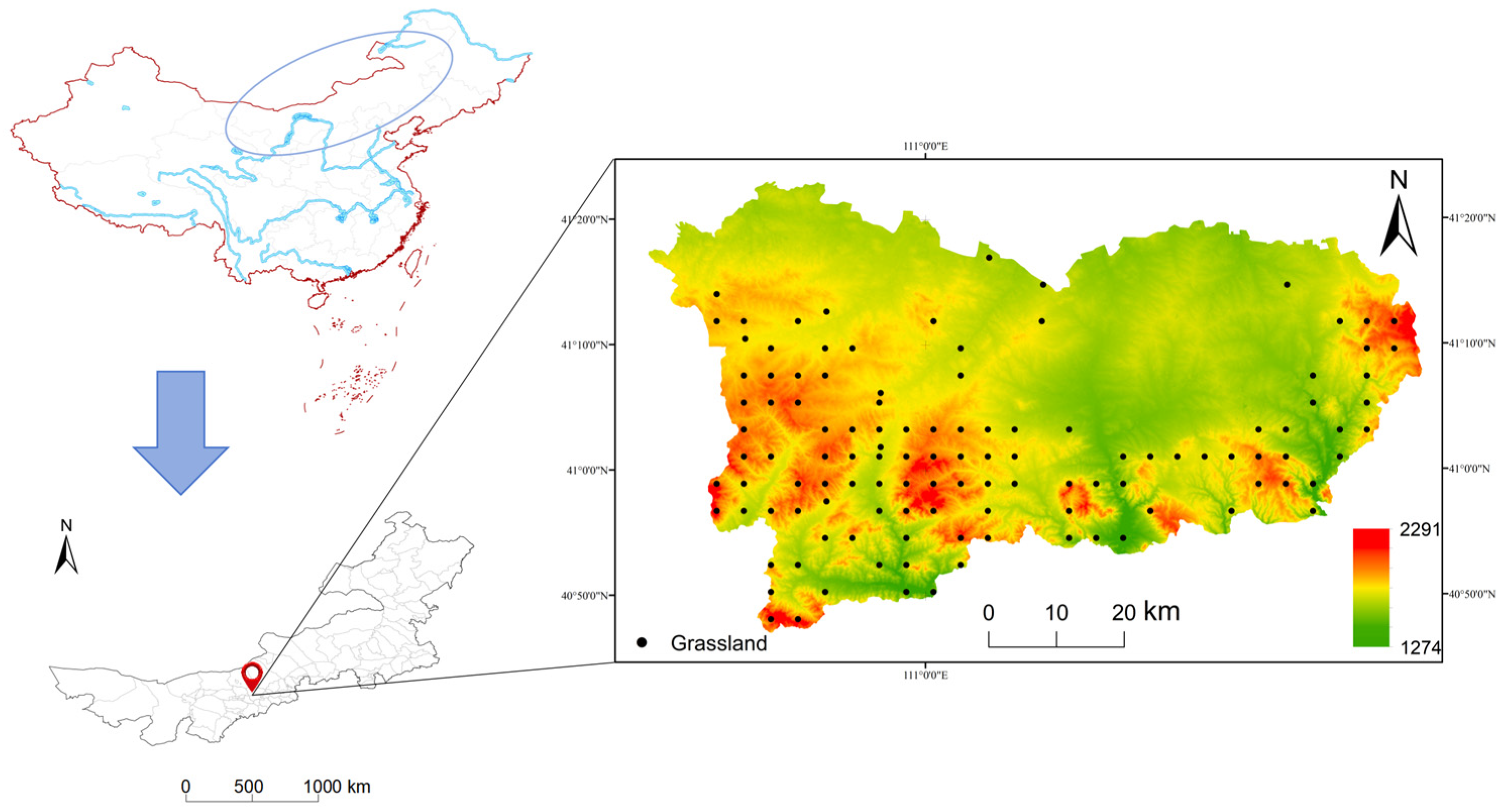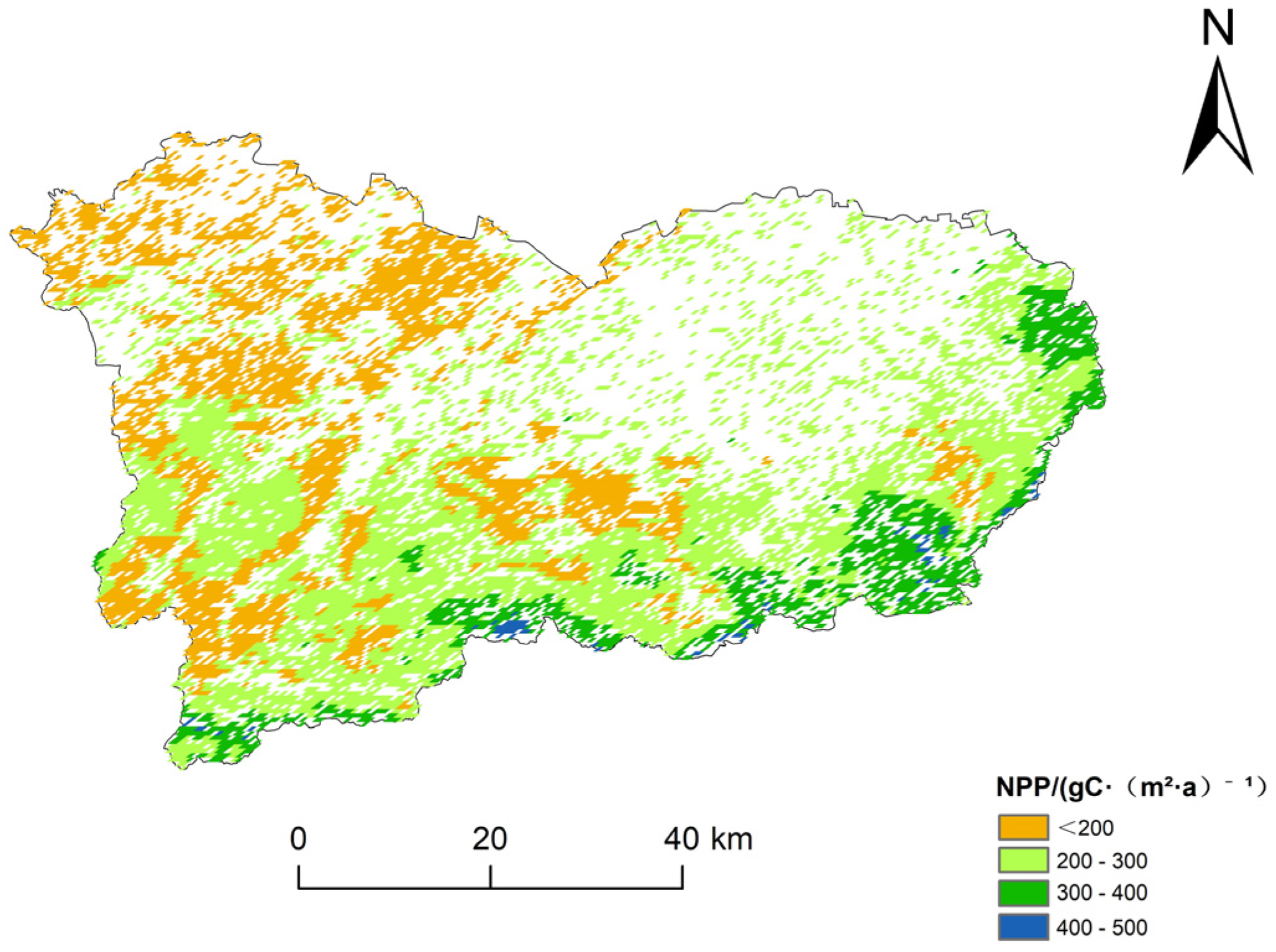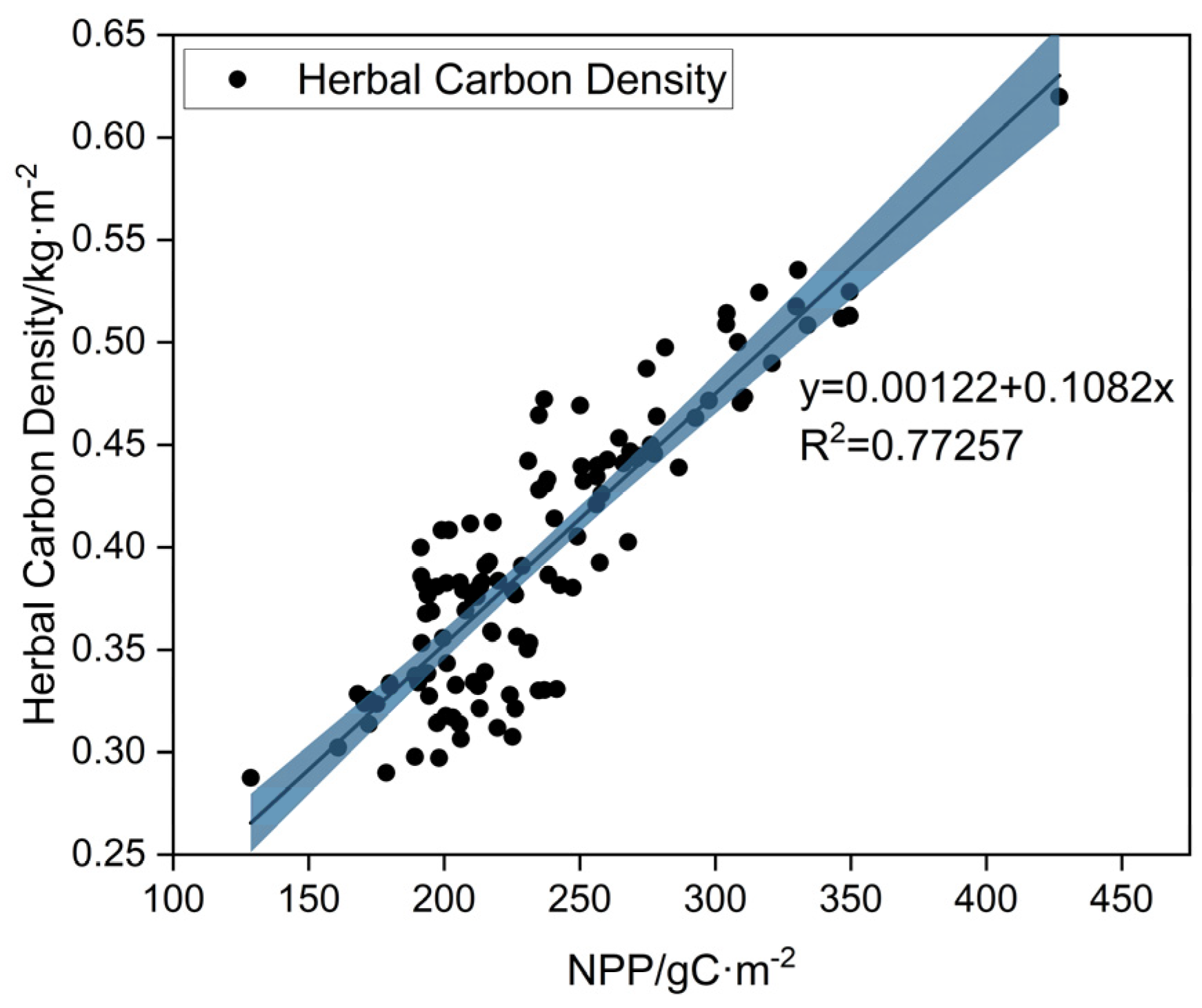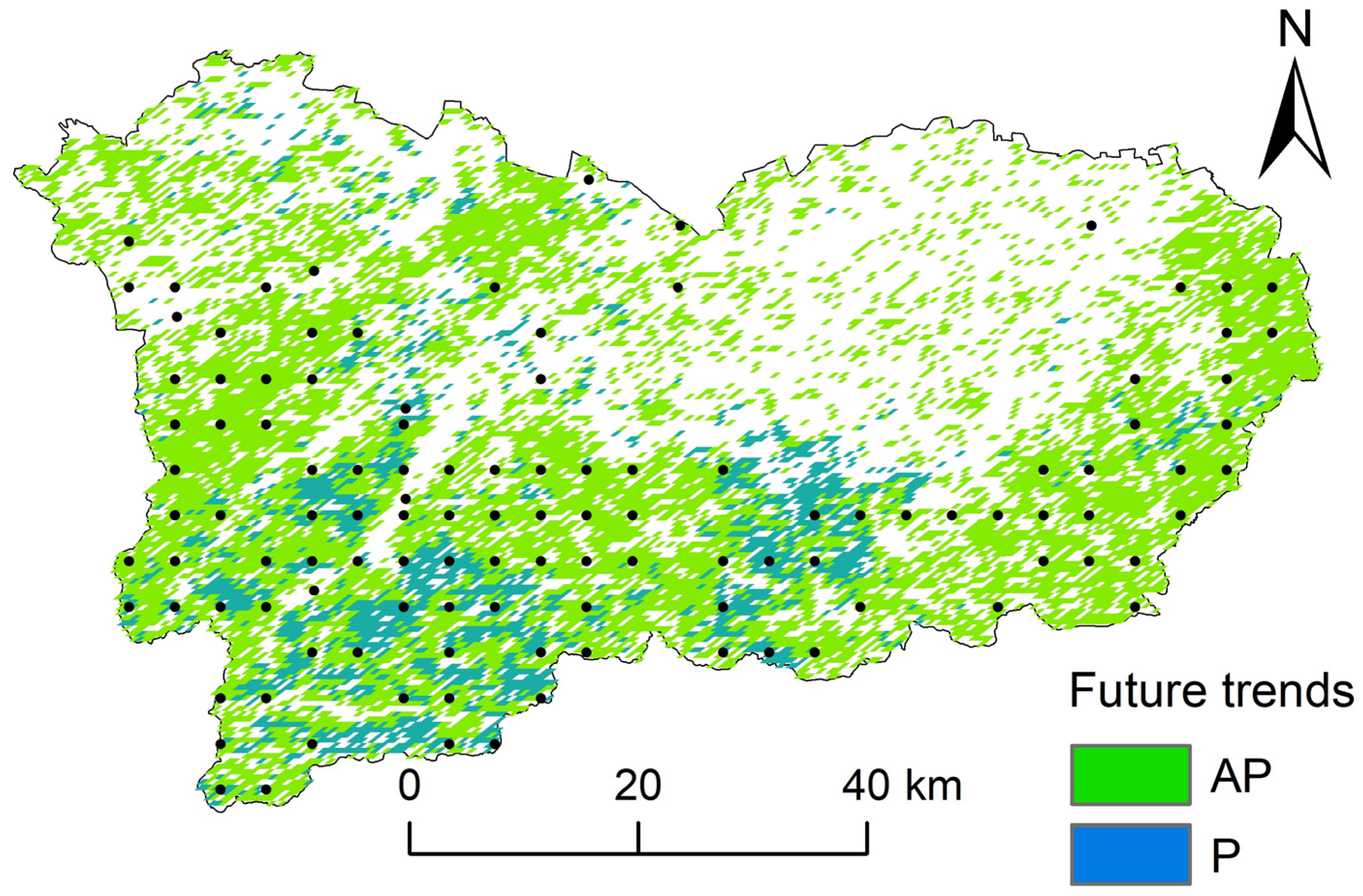Study on Carbon Stock and Sequestration Potential of Typical Grasslands in Northern China: A Case Study of Wuchuan County
Abstract
1. Introduction
2. Overview of the Study Area and Methods
2.1. Overview of the Study Area
2.2. Methods
2.3. Data Processing and Analysis
2.3.1. Calculation of Grassland Carbon Density and Carbon Stock
2.3.2. Analysis of the Relationship between Grassland Herbaceous Carbon Density and NPP
2.3.3. Prediction of Grassland Carbon Sequestration Potential
3. Results
3.1. Analysis of Carbon Stock and Carbon Density of Grasslands
3.2. Spatiotemporal Variation of Grassland NPP
3.3. Correlation Analysis between Herbaceous Carbon Density and NPP
3.4. Vegetation NPP Hurst Exponent and Prediction of Carbon Sequestration Potential
4. Discussion
4.1. Carbon Stock and Density in the Grassland Ecosystem of the Study Area
4.2. Carbon Stock and Density among Different Grassland Community Types
4.3. Correlation between Herbaceous Organic Carbon Density and NPP
4.4. Predictions of Carbon Sequestration Potential
5. Conclusions
- (1)
- A survey was conducted on the total carbon stock of grasslands within the study area, revealing a total carbon stock of 18.06 Mt and an average carbon density of 77.50 t/ha. Carbon density and stock were highest in the soil layer, followed by the herbaceous layer, and lowest in the litter layer. Among the communities, the Stipa krylovii + Leymus chinensis community exhibited the highest carbon density, whereas the Potentilla anserina + Artemisia frigida community had the lowest.
- (2)
- There was a positive correlation between herbaceous carbon density and NPP within the study area.
- (3)
- The Hurst exponent for NPP suggests that over the next two decades, the Net Primary Productivity of most grasslands in the study area is expected to show a gradual increase, enhancing the grasslands’ overall potential for carbon sequestration. Nevertheless, accounting for human activities and the challenges posed by climate change is essential.
Author Contributions
Funding
Institutional Review Board Statement
Informed Consent Statement
Data Availability Statement
Conflicts of Interest
References
- Fang, J.Y.; Yang, Y.H.; Ma, W.H.; Mohammat, A.; Shen, H. Ecosystem carbon stocks and their changes in China’s grasslands. Sci. China Life Sci. 2010, 53, 757–765. [Google Scholar] [CrossRef] [PubMed]
- Follett, R.F.; Reed, D.A. Soil Carbon Sequestration in Grazing Lands: Societal Benefits and Policy Implications. Rangel. Ecol. Manag. 2010, 63, 4–15. [Google Scholar] [CrossRef]
- Bardgett, R.D.; Bullock, J.M.; Lavorel, S.; Manning, P.; Schaffner, U.; Ostle, N.; Chomel, M.; Durigan, G.; Fry, E.L.; Johnson, D.; et al. Combatting global grassland degradation. Nat. Rev. Earth Environ. 2021, 2, 720–735. [Google Scholar] [CrossRef]
- Dai, E.; Zhai, R.; Ge, Q.; Wu, X. Detecting the storage and change on topsoil organic carbon in grasslands of Inner Mongolia from 1980s to 2010s. J. Geogr. Sci. 2014, 24, 1035–1046. [Google Scholar] [CrossRef]
- Sharkhuu, A.; Plante, A.F.; Enkhmandal, O.; Gonneau, C.; Casper, B.B.; Boldgiv, B.; Petraitis, P.S. Soil and ecosystem respiration responses to grazing, watering and experimental warming chamber treatments across topographical gradients in northern Mongolia. Geoderma 2016, 269, 91–98. [Google Scholar] [CrossRef] [PubMed]
- Ma, W.H.; Han, M.; Lin, X.; Ren, Y.; Wang, Z.; Fang, J. Carbon Storage in Vegetation of Grasslands in Inner Mongolia. J. Arid Land Resour. Environ. 2006, 20, 192–195. [Google Scholar] [CrossRef]
- Zhao, W.; Hu, Z.; Li, S.; Guo, Q.; Yang, H.; Zhang, T. Impact of land use conversion on soil organic carbon stocks in an agro-pastoral ecotone of Inner Mongolia. J. Geogr. Sci. 2017, 8, 999–1010. [Google Scholar] [CrossRef]
- Zhao, Y.; Li, Q.Z.; Wang, P.Y.; Jiang, Q. Changes of organic carbon density in desert steppe ecosystem driven by degradation and restoration. J. Desert Res. 2022, 42, 215–222. [Google Scholar]
- Bai, Y.F.; Chen, S.P. Carbon sequestration of Chinese grassland ecosystems: Stock, rate and potential. Chin. J. Plant Ecol. 2018, 42, 261–264. [Google Scholar] [CrossRef]
- Tao, F.; Huang, Y.; Hungate, B.A.; Manzoni, S.; Frey, S.D.; Schmidt, M.W.I.; Reichstein, M.; Carvalhais, N.; Ciais, P.; Jiang, L.; et al. Microbial carbon use efficiency promotes global soil carbon storage. Nature 2023, 618, 981–985. [Google Scholar] [CrossRef]
- Woodall, C.W.; Walters, B.F.; Coulston, J.W.; D’amato, A.W.; Domke, G.M.; Russell, M.B.; Sowers, P.A. Monitoring Network Confirms Land Use Change is a Substantial Component of the Forest Carbon Sink in the eastern United States. Sci. Rep. 2015, 5, 17028. [Google Scholar] [CrossRef] [PubMed]
- Yu, W.Y.; Qi, Y.B.; Ming, H. Provincial Difference and Influence Factors of Carbon Source and Sink of Agricultural System in China. J. West China For. Sci. 2016, 45, 1–7. [Google Scholar]
- Scurlock, J.M.O.; Hall, D.O. The global carbon sink: A grassland perspective. Glob. Change Biol. 1998, 4, 229–233. [Google Scholar] [CrossRef]
- Yuan, Y.Q.; Xue, L.M.; Li, X.Z. Net primary productivity and carbon sequestration potential of salt marsh vegetation in Chongming Dongtan of the Yangtze Estuary based on CASA model. Chin. J. Ecol. 2022, 41, 334–342. [Google Scholar] [CrossRef]
- Luo, Y.; White, L.W.; Canadell, J.G.; DeLucia, E.H.; Ellsworth, D.S.; Finzi, A.; Lichter, J.; Schlesinger, W.H. Sustainability of terrestrial carbon sequestration: A case study in Duke Forest with inversion approach. Glob. Biogeochem. Cycles 2003, 17, 1923. [Google Scholar] [CrossRef]
- Zhang, X.; Jia, J.; Chen, L.; Chu, H.; He, J.-S.; Zhang, Y.; Feng, X. Aridity and NPP constrain contribution of microbial necromass to soil organic carbon in the Qinghai-Tibet alpine grasslands. Soil Biol. Biochem. 2021, 156, 108213. [Google Scholar] [CrossRef]
- Bai, Y.; Zhao, Y.; Wang, Y.; Zhou, K. Assessment of Ecosystem Services and Ecological Regionalization of Grasslands Support Establishment of Ecological Security Barriers in Northern China. Bull. Chin. Acad. Sci. 2020, 35, 675–689. [Google Scholar]
- Wei, Y.J.; Liu, M.Y.; Ji, W.; Dang, X.H.; Han, Y.L. The effects of vegetation communities on soil organic carbon stock in an enclosed desert-steppe region of northern China. Soil Sci. Plant Nutr. 2022, 68, 284–294. [Google Scholar]
- Sha, Z.; Bai, Y.; Lan, H.; Liu, X.; Li, R.; Xie, Y. Can more carbon be captured by grasslands? A case study of Inner Mongolia, China. Sci. Total. Environ. 2020, 723, 138085. [Google Scholar] [CrossRef]
- Zhang, J.; Zhang, C.H.; Zhang, A.D.; Fang, M.; Wu, M.; Lin, Z.; Zhang, Y.; Song, X. Relative effects of hydrothermal fluctuation and land cover changes on vegetation net primary productivity in Northeast China. Acta. Ecol. Sin. 2020, 40, 7733–7744. [Google Scholar] [CrossRef]
- Zhao, X.X. The Spatio-temporal Dynamics and Driving Factors of Grassland Net Primary Productivity in the Farming-pastoral Ecotone of Inner Mongolia. Master’s Thesis, Inner Mongolia University, Hohhot, China, 2022. [Google Scholar] [CrossRef]
- Xin, X.P.; Ding, L.; Cheng, W.; Zhu, X.Y.; Chen, B.H.; Liu, Z.L.; He, G.L.; Qing, G.L.; Yang, G.X.; Tang, H.J. Biomass Carbon Storage and Its Effect Factors in Steppe and Agro-Pastoral Ecotones in Northern China. Sci. Agric. Sin. 2020, 53, 2757–2768. [Google Scholar]
- Yang, M.X.; Yang, X.C.; Zhao, Y.; Huangqing, D.; Li, C.; Cao, W.; Chen, A.; Gu, Q.; Li, Z.; Wang, S. Estimated carbon storage and influencing factors of alpine grassland in the source region of the Yellow River. Acta Ecol. Sin. 2023, 43, 3546–3557. [Google Scholar] [CrossRef]
- Huang, X.Q.; Li, E.G.; Zhang, J.; Qi, Y.; Chen, H.; Zhou, Y.; Yang, C.; Huang, Y. Soil organic carbon stock and its influencing factors under different vegetation types in western Inner Mongolia. J. Arid Land Resour. Environ. 2016, 30, 165–171. [Google Scholar] [CrossRef]
- Qiu, X. The Effect of Grazing and Climate Change on Characteristics of Vegetation and Cycle of Soil Carbon and Nitrogen in Grassland Ecosystem. Master’s Thesis, Inner Mongolia University, Hohhot, China, 2023. [Google Scholar] [CrossRef]
- Zhang, H.-L.; Song, K.; Shi, J.; Wu, Y.; Zheng, X.-Q.; He, Q.-Y.; Li, S.-X.; Zhang, J.-Q.; Shen, G.-R.; Lv, W.-G. Spatial Distribution and Storage Feature of Deep Soil Organic Carbon in Chongming Island. Chin. J. Agrometeorol. 2017, 38, 567–573. [Google Scholar]
- Cui, X.; Wang, Y.; Niu, H.; Wu, J.; Wang, S.; Schnug, E.; Rogasik, J.; Fleckenstein, J.; Tang, Y. Effect of long-term grazing on soil organic carbon content in semiarid steppes in Inner Mongolia. Ecol. Res. 2005, 20, 519–527. [Google Scholar] [CrossRef]
- Zhang, Z.; Wang, Y.; Wang, Y.; Deng, X.; Hao, G.; Wang, F.; Qin, Z. Distribution patterns and influencing factors of soil carbon storage in mangrove wetland at the Pear River Estuary. Acta Sci. Circumstantiae 2023, 43, 297–306. [Google Scholar] [CrossRef]
- Zhang, L.; Zhou, G.; Ji, Y.; Bai, Y. Spatiotemporal dynamic simulation of grassland carbon storage in China. Sci. China Earth Sci. 2016, 59, 1946–1958. [Google Scholar] [CrossRef]
- Piao, S.L.; Fang, J.Y.; He, J.S.; Xiao, Y. Spatial Distribution of Grassland Biomass in China. Chin. J. Plant Ecol. 2004, 28, 491–498. [Google Scholar] [CrossRef]
- Potter, C.; Gross, P.; Genovese, V.; Smith, M.-L. Net primary productivity of forest stands in New Hampshire estimated from Landsat and MODIS satellite data. Carbon Balance Manag. 2007, 2, 9. [Google Scholar] [CrossRef]
- Schlesinger, W.H.; Andrews, J.A. Soil respiration and the global carbon cycle. Biogeochemistry 2000, 48, 7–20. [Google Scholar] [CrossRef]
- Sullivan, P.F.; Arens, S.J.T.; Sveinbjörnsson, B.; Welker, J.M. Modeling the seasonality of belowground respiration along an elevation gradient in the western Chugach Mountains, Alaska. Biogeochemistry 2010, 101, 61–75. [Google Scholar] [CrossRef]




| Different Soil Layers | Carbon Stock (×104 tons) | Carbon Density (t/ha) |
|---|---|---|
| 0–20 cm | 435.39 | 18.69 |
| 20–50 cm | 640.33 | 27.48 |
| 50–100 cm | 623.89 | 26.78 |
| Total | 1699.61 | 72.95 |
| Community Name | Number of Samples | Biomass (×104 tons) | Carbon Density (t/ha) | Carbon Stock (×104 tons) |
|---|---|---|---|---|
| Stipa krylovii + Leymus chinensis | 43 | 19.80 | 88.32 | 711.90 |
| Artimisia frigida + Stipa krylovii | 32 | 12.74 | 78.75 | 663.38 |
| Stipa krylovii + Cleistogenes squarrosa | 20 | 6.74 | 80.00 | 324.47 |
| Salsola collina + Artimisia frigida | 11 | 4.05 | 60.78 | 59.58 |
| Artimisia frigida + Cleistogenes squarrosa | 4 | 1.39 | 71.96 | 24.15 |
| Thymus mongolicus + Artimisia frigida | 4 | 0.87 | 74.23 | 15.85 |
| Thymus mongolicus + Stellera chamaejasme | 2 | 0.51 | 71.29 | 6.32 |
| Total/Average | 116 | 46.09 | 77.50 | 1805.65 |
Disclaimer/Publisher’s Note: The statements, opinions and data contained in all publications are solely those of the individual author(s) and contributor(s) and not of MDPI and/or the editor(s). MDPI and/or the editor(s) disclaim responsibility for any injury to people or property resulting from any ideas, methods, instructions or products referred to in the content. |
© 2024 by the authors. Licensee MDPI, Basel, Switzerland. This article is an open access article distributed under the terms and conditions of the Creative Commons Attribution (CC BY) license (https://creativecommons.org/licenses/by/4.0/).
Share and Cite
Gao, F.; Tian, Z.; Wang, Y.; Yang, Z.; Ding, G. Study on Carbon Stock and Sequestration Potential of Typical Grasslands in Northern China: A Case Study of Wuchuan County. Sustainability 2024, 16, 4053. https://doi.org/10.3390/su16104053
Gao F, Tian Z, Wang Y, Yang Z, Ding G. Study on Carbon Stock and Sequestration Potential of Typical Grasslands in Northern China: A Case Study of Wuchuan County. Sustainability. 2024; 16(10):4053. https://doi.org/10.3390/su16104053
Chicago/Turabian StyleGao, Fan, Zhen Tian, Yanzhe Wang, Zhiheng Yang, and Guodong Ding. 2024. "Study on Carbon Stock and Sequestration Potential of Typical Grasslands in Northern China: A Case Study of Wuchuan County" Sustainability 16, no. 10: 4053. https://doi.org/10.3390/su16104053
APA StyleGao, F., Tian, Z., Wang, Y., Yang, Z., & Ding, G. (2024). Study on Carbon Stock and Sequestration Potential of Typical Grasslands in Northern China: A Case Study of Wuchuan County. Sustainability, 16(10), 4053. https://doi.org/10.3390/su16104053





